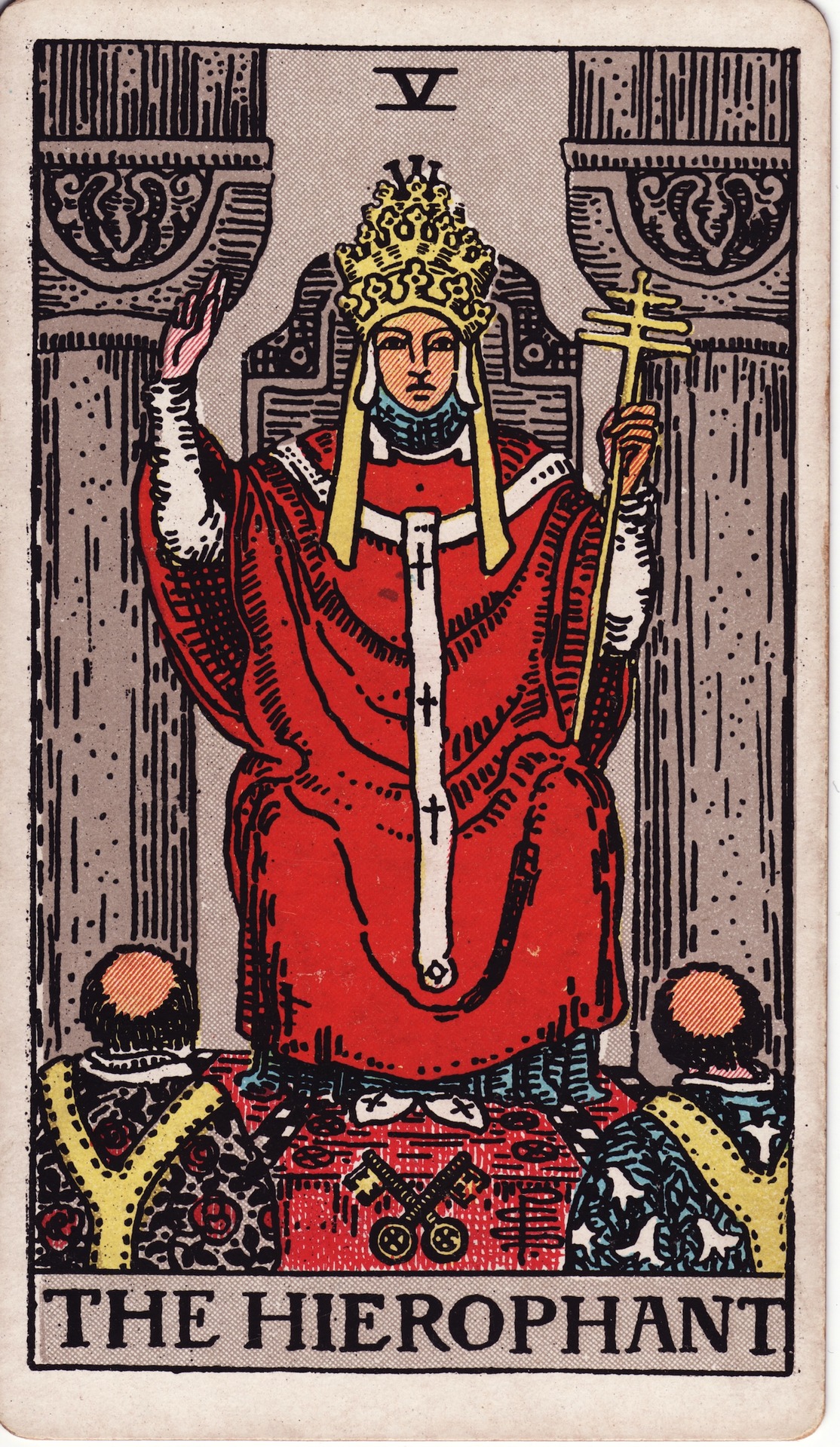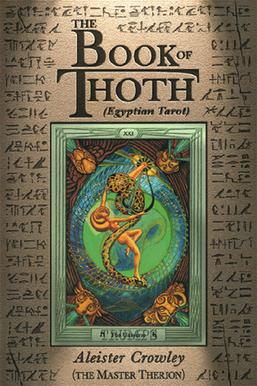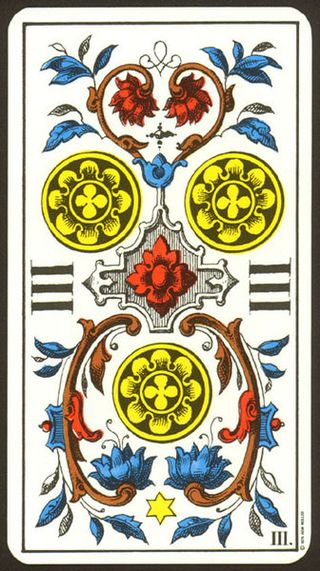Related Research Articles

A goddess is a female deity. In many known cultures, goddesses are often linked with literal or metaphorical pregnancy or imagined feminine roles associated with how women and girls are perceived or expected to behave. This includes themes of spinning, weaving, beauty, love, sexuality, motherhood, domesticity, creativity, and fertility. Many major goddesses are also associated with magic, war, strategy, hunting, farming, wisdom, fate, earth, sky, power, laws, justice, and more. Some themes, such as discord or disease, which are considered negative within their cultural contexts also are found associated with some goddesses. There are as many differently described and understood goddesses as there are male, shapeshifting, or neuter gods.

Tarot is a pack of playing cards, used from at least the mid-15th century in various parts of Europe to play card games such as Tarocchini. From their Italian roots, tarot-playing cards spread to most of Europe, evolving into a family of games that includes German Grosstarok and modern games such as French Tarot and Austrian Königrufen. In the late 18th century French occultists made elaborate, but unsubstantiated, claims about their history and meaning, leading to the emergence of custom decks for use in divination via tarot card reading and cartomancy. Thus, there are two distinct types of tarot packs in circulation: those used for card games and those used for divination. However, some older patterns, such as the Tarot de Marseille, originally intended for playing card games, are occasionally used for cartomancy.

The Rider–Waite Tarot is a widely popular deck for tarot card reading. It is also known as the Waite–Smith, Rider–Waite–Smith, or Rider Tarot. Based on the instructions of academic and mystic A. E. Waite and illustrated by Pamela Colman Smith, both members of the Hermetic Order of the Golden Dawn, the cards were originally published by the Rider Company in 1909. The deck has been published in numerous editions and inspired a wide array of variants and imitations. It is estimated that more than 100 million copies of the deck exist in more than 20 countries.

The Hierophant (V) is the fifth card of the Major Arcana in occult Tarot decks. It is derived from the historical card known as the Pope in playing card decks. It is used in divination. The name refers to a hierophant (Ancient Greek: ἱεροφάντης), a person who brings religious congregants into the presence of that which is deemed "holy".

Pamela Colman Smith, nicknamed "Pixie", was a British artist, illustrator, writer, publisher, and occultist. She is best-known for illustrating the Rider–Waite tarot deck for Arthur Edward Waite. This tarot deck became the standard among tarot card readers, and remains the most widely used today. Smith also illustrated over 20 books, wrote two collections of Jamaican folklore, edited two magazines, and ran the Green Sheaf Press, a small press focused on women writers.

Zsuzsanna Emese Mokcsay is a Hungarian-American writer, activist, playwright and songwriter living in America who writes about feminist spirituality and Dianic Wicca under the pen name Zsuzsanna Budapest or Z. Budapest. She is the founder of the Susan B. Anthony Coven #1, which was founded in 1971 as the first women-only witches' coven. She founded the female-only style of Dianic Wicca.

Temperance (XIV) is one of the 22 Major Arcana cards in Tarot decks. It is usually numbered 14. It depicts a figure which represents the virtue Temperance. Along with Justice and Strength, it is one of three Virtues which are given their own cards in traditional tarot. It is used in both game playing and in divination.
Víctor Sánchez is a Mexican author. He was initially inspired by the writings of Carlos Castaneda and by his own studies among the Wirrarika, said to be cultural descendants of the Pre-Columbian Native American Toltecs.

The Visconti-Sforza Tarot is used collectively to refer to incomplete sets of approximately 15 decks from the middle of the 15th century, now located in various museums, libraries, and private collections around the world. No complete deck has survived; rather, some collections boast a few face cards, while some consist of a single card. They are the oldest surviving tarot cards and date back to a period when tarot was still called Trionfi cards, and used for everyday playing. They were commissioned by Filippo Maria Visconti, Duke of Milan, and by his successor and son-in-law Francesco Sforza. They had a significant impact on the visual composition, card numbering and interpretation of modern decks.
Barbara G. Walker is an American author and feminist. She is a knitting expert and the author of over ten encyclopedic knitting references, despite "not taking to it at all" when she first learned in college. Other topics she has written about are religion, New Age, the occult, spirituality, and mythology.

The Book of Thoth: A Short Essay on the Tarot of the Egyptians is the title of The Equinox, volume III, number 5, by English author and occultist Aleister Crowley. The publication date is recorded as the vernal equinox of 1944 and was originally published in an edition limited to 200 numbered and signed copies.

Four of Coins is a card used in Latin-suited playing cards, which include tarot decks. It is part of what tarot card readers call the "Minor Arcana".

The suit of coins is one of the four suits used in tarot decks with Latin-suited cards. It is derived from the suit of coins in Italian and Spanish card playing packs.

The Ace of Wands is a tarot card of the Minor Arcana, arcana being Latin for mysteries. The cards of the Minor Arcana are considered to be lesser compared to the Major Arcana because they discuss the minor mysteries of life, less important archetypes. Modern tarot readers interpret the Ace of Wands as a symbol of optimism and invention.

Luisah Teish is a teacher and an author, most notably of Jambalaya: The Natural Woman's Book of Personal Charms and Practical Rituals. She is an Iyanifa and Oshun chief in the Yoruba Lucumi tradition.
Deanna "D. J." Conway was a non-fiction author of books in the field of magic, Wicca, Druidism, shamanism, metaphysics and the occult, and the author of three fantasy novels. Born in Hood River, Oregon to a family of Irish, North Germanic, and Native North American descent, she studied the occult and Pagan religion for over thirty years. In 1998 she was voted Best Wiccan and New Age author by Silver Chalice, a Neo-Pagan magazine. She was an ordained minister in two New Age churches and holder of a Doctor of Divinity degree. Several of her stories were published in magazines, such as the science fantasy publication Encounters, and she was interviewed in magazines and appeared on such television shows as Journey with Brenda Roberts. She also designed Tarot decks, in collaboration with fellow author Sirona Knight and illustrator Lisa Hunt.

The suit of swords is one of the four suits of the Minor Arcana in a 78-card cartomantic tarot deck. It is derived from the suit used in Latin-suited playing cards, such as Spanish, Italian and Latin-suited tarot decks. Like the other tarot suits, it contains fourteen cards: ace (one), two through ten, page, knight, queen and king. Occultists claim that the suit represents the Second Estate.
The Motherpeace Tarot is a deck of tarot cards inspired by the Goddess movement and second-wave feminism. Created by Karen Vogel and Vicki Noble in the 1970s, it has never been out of print, and in 2017 was the subject of a Christian Dior fashion collection.
U.S. Games Systems, Inc. (USGS) is a publisher of playing cards, tarot cards, and games located in Stamford, Connecticut. Founded in 1968 by Stuart R. Kaplan, it has published hundreds of different card sets, and about 20 new titles are released annually. The company's product line includes children's card games, museum products, educational cards, motivational cards, tarot cards, and fortune telling decks. These are marketed through a network of retailers, including bookstores, museum gift shops, metaphysical shops, greeting card stores; toy and game stores; hobby shops, and mail order catalogs.
Glenys Livingstone is an Australian author and teacher who has made significant contributions to the feminist pagan community and is the creator of the earth-based goddess movement known as PaGaian Cosmology.
References
- ↑ Katherine Neville Website
- ↑ Vicki Noble's CV on the University Faculty page accessed 26 March 2010
- ↑ Motherpeace Website: Biographies
- ↑ "Goddess gathering" (July 21, 2011). Wells Journal , p. 41.
- ↑ Vogel, Karen. (2003). "Female Shamanism, Goddess Cultures, and Psychedelics". Revision, 25(3), p. 18.